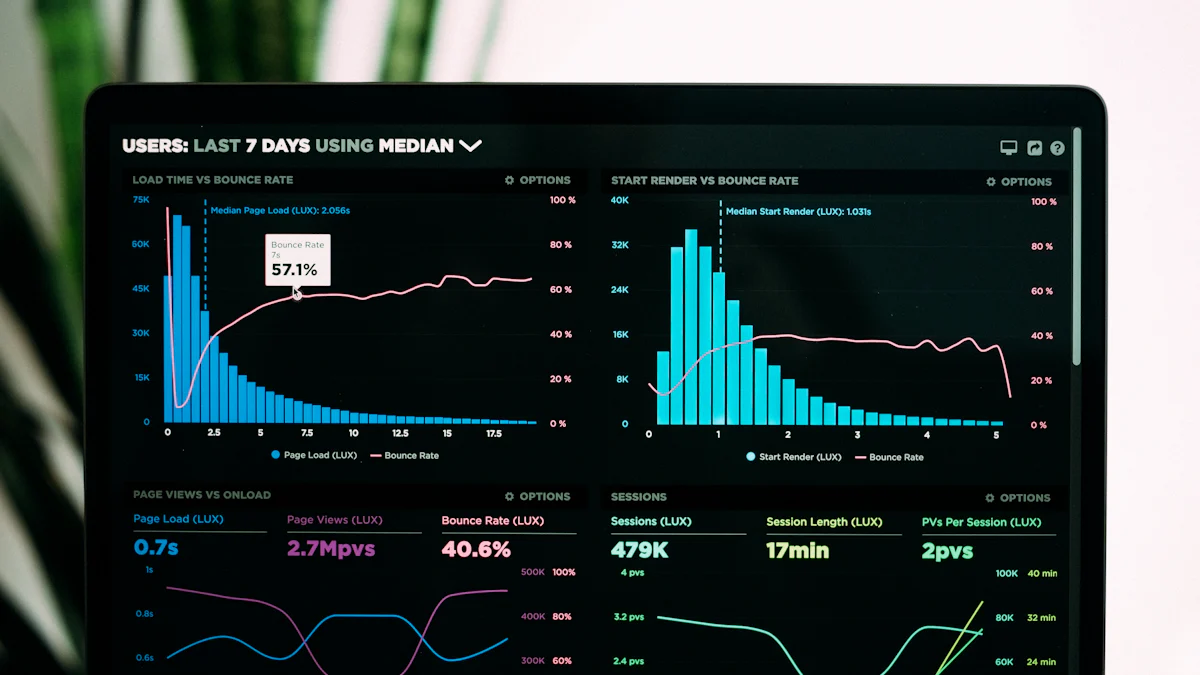Real-time data refers to information that is collected and processed immediately as events occur. Real-time data processing enables businesses to access insights without delay, which is crucial for making timely decisions. In marketing, real-time data holds immense importance. It allows marketers to swiftly adapt to market fluctuations and make informed choices.
Leveraging real-time data offers several benefits:
- Enhanced customer engagement: McDonald's saw a 30% increase in customer engagement through real-time analytics.
- Improved retention rates: Real-time data analytics boosted McDonald's retention rates by 10%.
- Increased customer retention: 58% of business leaders reported improved customer retention due to real-time data analytics.
Understanding Real-Time Data
What is Real-Time Data?
Definition and Characteristics
Real-time data refers to information collected and processed immediately as events unfold. This type of data provides instantaneous insights, enabling businesses to make timely decisions. Real-time data processing ensures that data is available for analysis the moment it is generated. This minimizes latency and enhances decision-making capabilities.
Characteristics of real-time data include:
- Immediacy: Data is processed without delay.
- Continuity: Data flow is continuous, providing up-to-date information.
- Relevance: Data remains relevant due to its timeliness.
Sources of Real-Time Data
Various sources generate real-time data. These include:
- Social Media Platforms: Platforms like Twitter and Facebook provide real-time updates on user activities and trends.
- Web Analytics: Tools like Google Analytics offer real-time insights into website traffic and user behavior.
- IoT Devices: Internet of Things devices continuously collect and transmit data.
- Transactional Systems: Point-of-sale systems and online transactions generate real-time data.
Importance of Real-Time Data in Marketing
Enhancing Customer Experience
Real-time data significantly enhances customer experience. Businesses can interact with their audience promptly, crafting messages or offers that resonate at that particular moment. For example, McDonald's saw a 30% increase in customer engagement through real-time analytics. Real-time data allows marketers to personalize interactions, meeting consumer expectations for instant gratification.
Improving Decision-Making
Real-time data empowers marketers to make informed decisions swiftly. Companies like Tetris.co (now NeoDash) unify data from multiple media sources. This enables front-line analysts to understand trends faster and shift investments into higher-performing channels. Real-time data analytics provide nearly instantaneous insights, allowing decision-makers to streamline operations and respond to market demands effectively.
Practical Applications of Real-Time Data in Marketing
Real-Time Data in Customer Segmentation
Identifying Target Audiences
Real-time data processing allows marketers to identify target audiences with precision. By analyzing data from social media platforms, web analytics, and transactional systems, businesses can segment customers based on their behaviors and preferences. This segmentation provides a clear understanding of who the customers are and what they need. For instance, a retail company can use real-time data to identify frequent buyers and tailor exclusive offers to them.
Personalizing Marketing Campaigns
Personalized marketing campaigns become more effective with real-time data processing. Marketers can create tailored messages and offers that resonate with individual customers. For example, a streaming service can recommend shows based on a user's recent viewing history. This level of personalization increases engagement and conversion rates. Real-time data ensures that marketing efforts remain relevant and timely, enhancing the overall customer experience.
Real-Time Data in Social Media Marketing
Monitoring Trends and Sentiments
Social media platforms generate vast amounts of real-time data. Marketers can monitor trends and sentiments to understand public opinion and emerging topics. Tools like sentiment analysis can gauge the mood of online conversations. This insight helps businesses stay ahead of trends and adjust their strategies accordingly. For example, a fashion brand can quickly identify trending styles and incorporate them into their product lines.
Engaging with Customers in Real-Time
Engaging with customers in real-time enhances brand loyalty and satisfaction. Real-time data processing enables businesses to respond to customer inquiries and feedback instantly. For instance, a travel agency can address customer concerns about flight delays as they happen. This immediate interaction builds trust and fosters a positive relationship with the audience. Real-time engagement also allows for timely promotions and offers, driving sales and customer retention.
Real-Time Data in Email Marketing
Optimizing Send Times
Optimizing send times for email campaigns becomes possible with real-time data processing. Marketers can analyze when recipients are most likely to open and engage with emails. This data-driven approach ensures that emails reach the inbox at the optimal time, increasing open rates and conversions. For example, an e-commerce store can schedule promotional emails during peak shopping hours to maximize impact.
Personalizing Content
Personalizing email content based on real-time data enhances the relevance and effectiveness of campaigns. Marketers can tailor emails to reflect the recipient's recent interactions and preferences. For instance, a fitness app can send workout recommendations based on a user's activity history. Personalized content resonates more with recipients, leading to higher engagement and customer satisfaction.
Case Studies and Examples
Successful Use Cases
Company A's Real-Time Data Strategy
Uber implemented a robust real-time data strategy to enhance its service efficiency. By leveraging real-time analytics, Uber achieved a 25% decrease in average wait times for riders. This improvement directly impacted customer satisfaction. Additionally, Uber's drivers experienced a 10% increase in earnings. The company's ability to adapt to real-time consumer behavior and market dynamics played a crucial role in these outcomes.
Company B's Real-Time Data Implementation
Zara utilized predictive analytics to implement real-time solutions in its supply chain management. Zara's approach allowed the company to respond swiftly to changing fashion trends. The real-time data enabled Zara to optimize inventory levels and reduce stockouts. As a result, Zara maintained a competitive edge in the fast-paced fashion industry. The company's success demonstrates the value of specialized marketing analytics tools for impactful results.
Lessons Learned from Failures
Common Pitfalls
Many companies face challenges when integrating real-time data into their marketing strategies. One common pitfall involves data overload. Businesses often collect vast amounts of data without a clear plan for analysis. This leads to confusion and inefficiency. Another frequent issue is the lack of integration between different data sources. Disconnected data systems hinder the ability to gain comprehensive insights.
How to Avoid Them
To avoid these pitfalls, businesses should adopt a structured approach to data collection and analysis. Establishing clear objectives for data use ensures that only relevant information is gathered. Implementing integrated data systems allows for seamless data flow and comprehensive analysis. Companies should invest in training their teams to effectively utilize real-time data tools. This investment enhances decision-making capabilities and drives marketing success.
Tools and Technologies for Leveraging Real-Time Data
Data Analytics Platforms
Features to Look For
Selecting the right data analytics platform is crucial for effective real-time data processing. Key features to look for include:
- Scalability: The platform should handle large volumes of data without performance degradation.
- Integration Capabilities: Seamless integration with existing systems and data sources is essential.
- User-Friendly Interface: An intuitive interface allows users to navigate and utilize the platform efficiently.
- Advanced Analytics: Support for machine learning algorithms and predictive analytics enhances data insights.
- Real-Time Processing: Immediate data processing ensures timely decision-making.
Popular Platforms
Several platforms stand out in the market for their robust capabilities:
- Memgraph: A real-time graph streaming platform that enables data exploration both locally and on the cloud. Memgraph's streaming analytics system allows users to import data from various platforms and perform analysis without custom solutions.
- IBM Stream Analytics: This platform helps create customized, real-time streaming applications. IBM Stream Analytics ingests, analyzes, and correlates information from numerous data sources in real-time.
- Amazon Kinesis: Known for its flexibility, Amazon Kinesis allows enterprises to start with basic reports and insights. As demand grows, Kinesis supports the deployment of machine learning algorithms for in-depth analysis.
- Exasol: Exasol offers a real-time analytics database with an affordable pay-as-you-use model. Its open, flexible, and extensible architecture integrates seamlessly into existing data environments.
Real-Time Data Integration Tools
Benefits of Integration
Integrating real-time data across various platforms provides several benefits:
- Unified Data View: Integration creates a comprehensive view of data from multiple sources.
- Enhanced Decision-Making: Access to integrated data enables more informed and timely decisions.
- Operational Efficiency: Streamlined data flow reduces redundancy and improves operational efficiency.
- Improved Customer Insights: Integrated data offers a holistic understanding of customer behavior and preferences.
Top Tools in the Market
Several tools excel in real-time data integration:
- Apache Kafka: A distributed streaming platform that handles real-time data feeds. Kafka's scalability and fault-tolerance make it ideal for high-throughput environments.
- Talend: Talend provides robust data integration solutions with real-time processing capabilities. Its open-source nature allows for extensive customization.
- StreamSets: StreamSets offers a data operations platform designed for continuous data movement. It supports real-time data ingestion and integration across various systems.
- Microsoft Azure Stream Analytics: This tool processes real-time data streams from multiple sources. Azure Stream Analytics integrates seamlessly with other Azure services, providing a comprehensive data solution.
Real-time data processing plays a pivotal role in modern marketing. Marketers can enhance customer engagement and improve decision-making. Real-time data enables businesses to identify trends and adjust campaigns promptly. This proactive approach leads to increased customer satisfaction and effective marketing strategies.
Key points discussed include the definition and importance of real-time data, practical applications, and successful case studies. Leveraging real-time data provides a competitive edge in a rapidly changing market. Businesses should invest in the right tools and technologies to harness the full potential of real-time data.






